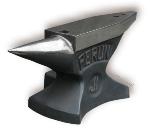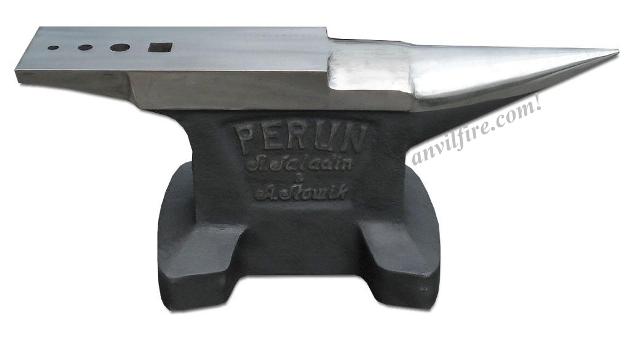Photo provided by Perun, Poland
There are very few modern "non-traditional" anvils that are a good design both functionaly and artistcally.
This is one of the very few exceptions.
This anvil was designed by Rolf Saladin a blacksmith living in Switzerland and the pattern made by Andrzej Słowik).
Probably the most important feature of this anvil is the curved "fuller" surface over the body.
Many smiths like to forge over the horn due to the greater efficiency of moving metal on a curved surface.
But this is dangerous to the standard anvil (the horn may break off - especially on old pieced or some cast anvils) and the unsupported horn is not an eficient place to forge.
This design avoids this problem.
Another interesting feature is the accute angle on one side of the heel.
This is a common sheet metal tool feature for overbending to compensate for spring back. Very handy on an anvil.
The anvil also has an upsetting block on the back side.
I think that functionally this is a facinating new anvil pattern that many smiths will like.
Artistically it is well designed but I am not impressed with the edge ledges (makes anvils look cheap) and the feet.
However, I am told that side ledges are traditional on cast anvils in Poland.
Weight: 100 kg (220 lbs)
Height: 275 mm (10-13/16")
Length: 670 mm (26-3/8")
Hardy Hole: 25 mm (~1 inch)
Pritchel Holes: 22mm, 16mm, 12mm (~7/8", 5/8" 1/2")
For more details see
anvilsperun.com/one_horn_anvilsB.html
Side Ledges: I believe this started as a machining allowance.
This is typical on castings of all types and a pattern maker who saw a "finish" mark on a drawing would have added a 1/4" ledge.
I've seen anvil blue prints with notes to finish the side a specific distance from the top.
Machining allowances should be machined off in the finishing process.
Many modern anvils are machined and ground.
Grinding allowances should be less than machining.
The problem with side ledges is that many low quality and cast iron anvils have them.
I have always believed this was an attempt to trick the unwary buyer into believing the anvil had a tool steel top plate when in fact they were a low quality casting.
As such I think side ledges should be avoided.

Perun Standard Two Horn Anvil
A current production anvil from Perun of Poland.

Perun Anvil Foundry Pattern
Split pattern with loose piece core.

Split Anvil Pattern
Small two piece wood foundry pattern.

Boxed Farrier Anvil Pattern
Mold box mounted pattern seen at SOFA QuadState in 2005.
Includes definitions of foundry pattern types.








städ, incus, aambeeld, batente, kowadło